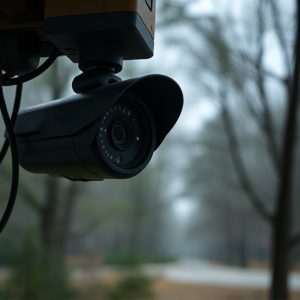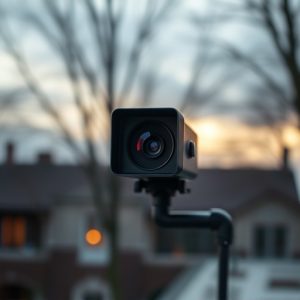Detect Hidden Cameras: RF Technology for Safe, Legal Disarming
Wireless nanny cameras without an internet connection use radio frequency (RF) waves for discreet su…….
Wireless nanny cameras without an internet connection use radio frequency (RF) waves for discreet surveillance, but they pose significant privacy risks by capturing sensitive information without consent. To protect against these hidden threats, individuals can use RF detection devices to scan for unique signals and visually inspect areas for visible components like antennas or connectors. However, it's crucial to understand legal boundaries and safety protocols when employing such methods, ensuring proper permissions are granted and safe distances are maintained to avoid legal issues and electromagnetic radiation risks.
In today’s digital age, privacy concerns have reached a boiling point. One insidious threat lurking in our midst is the wireless nanny cam without internet connection – hidden cameras disguised as everyday objects that transmit data through radio frequency (RF) signals. This comprehensive guide delves into the world of these clandestine devices, exploring their dangers and providing practical steps for detection using RF technology. Learn how to identify and disarm spy devices, along with essential legal considerations for staying safe in an increasingly connected world.
- Understanding Wireless Nanny Cameras: A Brief Overview
- The Dangers of Hidden Cameras in Everyday Life
- Detecting Hidden Cameras Using Radio Frequency (RF) Technology
- Practical Steps to Identify and Disarm RF-Enabled Spy Devices
- Legal Aspects and Safety Measures for RF Camera Detection
Understanding Wireless Nanny Cameras: A Brief Overview
Wireless nanny cameras, also known as hidden cameras that operate via radio frequency (RF), are a type of surveillance device designed to monitor activities without drawing attention. Unlike traditional wired cameras that require an internet connection for transmission, wireless nanny cameras function independently, making them ideal for discreet use. These devices transmit video signals over RF waves, allowing users to view live footage or record videos from a distance, often with a mobile app.
This technology offers several advantages, particularly in scenarios where a constant internet connection is unavailable or desired. A Wireless Nanny Cam Without Internet Connection can be easily installed and operated within a specific range, providing real-time monitoring for homes, offices, or any space where covert observation is required. Their lack of reliance on the internet ensures privacy and avoids potential risks associated with online data transmission.
The Dangers of Hidden Cameras in Everyday Life
In today’s digital era, convenience and surveillance have taken on new forms with the rise of wireless nanny cams without internet connection. While these devices seem like a helpful tool for monitoring homes or offices remotely, their hidden nature presents significant dangers in everyday life. The very fact that they are designed to operate discreetly means individuals may be completely unaware of their presence, invading privacy and fostering a sense of unease.
Hidden cameras can capture sensitive information, personal conversations, and intimate moments without consent, leading to severe security breaches and potential identity theft risks. They can be strategically placed in areas like bathrooms, bedrooms, or common spaces, raising ethical concerns about surveillance culture. As such, it’s crucial for folks to be vigilant, stay informed about the latest tactics used for hiding these devices, and take proactive measures to safeguard their personal spaces from such hidden threats.
Detecting Hidden Cameras Using Radio Frequency (RF) Technology
Detecting hidden cameras has become an essential skill in today’s digital age, where privacy concerns are on the rise. One innovative approach to this problem is using Radio Frequency (RF) technology. RF detection devices can identify wireless nanny cams or any other hidden camera that operates without an internet connection by scanning for unique radio signals. These signals are often emitted from the camera itself or the device that controls it, providing a way to uncover concealed surveillance equipment.
By employing RF sensors and analyzers, individuals can now proactively search for and detect these hidden cameras. This technology is particularly useful in situations where traditional visual detection methods might be limited, such as in dark areas or when direct line-of-sight access isn’t available. RF detection offers a non-intrusive way to ensure privacy and security by identifying and neutralizing hidden surveillance devices.
Practical Steps to Identify and Disarm RF-Enabled Spy Devices
To identify and disarm RF-enabled spy devices, like a wireless nanny cam without internet connection, follow these practical steps:
1. Frequency Scanning: Start by using a radio frequency (RF) detector to scan for unusual signals in the area of concern. These devices often operate on specific frequencies, so identifying an anomaly can point you towards a hidden camera. Pay close attention to any continuous or intermittent signal spikes that don’t align with known electronic equipment in the vicinity.
2. Manual Inspection: Once you’ve located a potential source using your RF detector, manually inspect the area for visible components. Spy cameras often have subtle physical indicators like tiny antennas, connectors, or odd markings. Look for any unusual objects or devices that seem out of place, as these could be parts of a hidden camera system.
Legal Aspects and Safety Measures for RF Camera Detection
When it comes to detecting hidden cameras using radio frequency (RF) technology, understanding legal boundaries and implementing safety measures is paramount. The use of RF detectors to uncover wireless nanny cams or any form of covert surveillance without proper authorization can be a complex legal matter. Many countries have strict privacy laws that protect individuals’ right to privacy in their homes or workplaces. Before employing RF detection methods, ensure you have the necessary permissions and are operating within the law to avoid potential legal repercussions.
Safety measures should also be prioritized during the detection process. RF detectors can help identify signals from various devices, but it’s crucial to differentiate between legitimate sources and hidden cameras. Proper training and expertise in RF technology are essential to interpret results accurately. Additionally, maintaining a safe distance from suspected camera locations is vital to minimize potential health risks associated with electromagnetic radiation, especially when dealing with homemade or unauthorized surveillance equipment.
Hidden cameras, particularly those operating without an internet connection as wireless nanny cameras, pose significant privacy risks in our daily lives. This article has explored the dangers of such devices and provided a comprehensive guide to detecting them using radio frequency (RF) technology. By understanding how these cameras work and implementing practical steps for identification and disarmament, individuals can take proactive measures to safeguard their privacy. Additionally, recognizing the legal aspects and safety measures associated with RF camera detection is essential to navigating this evolving technological landscape responsibly.

